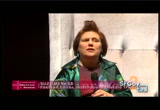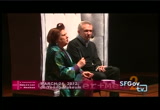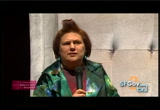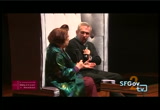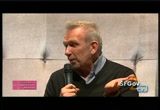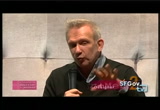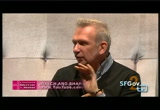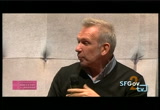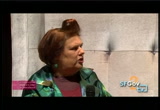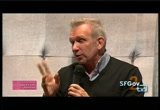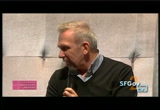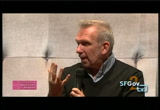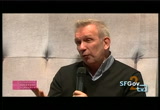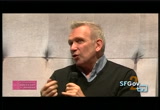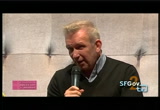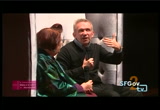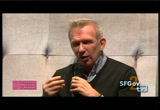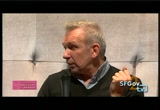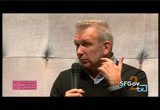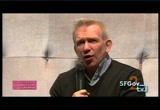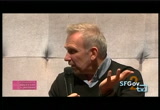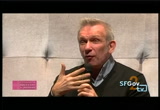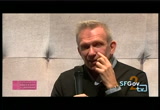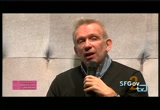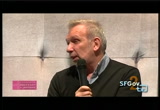tv [untitled] February 4, 2013 3:00am-3:30am PST
3:00 am
>> hi, thank you all for coming here today. i am the costume and textiles creator here at the fine arts museum. it is make great honor to introduce, to present this program today. just a few things come out of respect, photography is allowed, but no flash photography. we will be taking questions from the audience, and you can submit your questions either through twitter or e-mail, and we also handed out cards to you when you arrived. the questions will happen at the end of the program. if you are not planning to tweet or e-mail, please turn your cellphone off. again, it is my great honor to have this program and
3:01 am
conversation between susie and jean paul gaultier. i feel very fortunate at the fine arts museum because in fact susie mencus' son lives in the bay area and she comes frequently to visit the family. it is always my favorite time of in the exhibition, when she comes and i get to walk through the exhibition with her. it is so learnful. i wanted to share that opportunity with the rest of the bay area. one of my favorites, during the laurent exhibition, one of my favorite moments is one suzy stopped in her tracks. she said, this is it, this is what is true of any great artist or any great designer. when they do something, it can be shocking and avant-garde, but years later, we stand and look at it and believe it has always
3:02 am
existed. i think that this is true of jean paul gaultier's work. i know that have been friends for a very long time. it is my honor to introduce both suzy menkes, fashion editor of the international herald tribune, and mr. jean paul gaultier. [applause] >> the love seat. [laughter] i just want to know, can you hear me? please shout loudly if you cannot. [laughter] yes or no, you can hear? >> somebody said no. >> mic people, can i be heard? should i start? ok, good.
3:03 am
so before i introduced one of the funniest, wittiest, most amusing and funkiest designers that i know, i would like to start with something a little bit more serious. you know, in fashion, the reason that people laughed seem obvious when you see the exhibition of all it's incredible glory and excitement. but at the same time, there were real reasons why designers laughed, and one of them, when it comes to jean paul gaultier, is probably what is talked about least. it is the technique, the skill, the handwork, the knowledge. sometimes it gets buried underneath the fantasies of the close. but if you look hard, particularly those of you are going to go to the exhibition afterwards, if you look on one side to see the incredible punk can-can clothes, while,
3:04 am
exciting, a waterfall. then you look at the central lie all which is the per region and parts, you'll see the extraordinary crest -- kraft mentioned that can turn address and to have a jacket and half the skirt or can make a trench coat one of jean paul gaultier's iconic pieces and send it that is a trenchcoat but is also a pair of shorts. these kind of things, they're not tricks. their works of extraordinary skill. if you search in the exhibition, you will find that. you'll see the very early years that jean paul spend when he was learning paris couture. eglin said this young man looking very serious as he sits -- you will see this young man looking very serious as he sits and you will realize this is not a miracle. there was a solid basis. the other thing i want to say is that, you know, they're not many
3:05 am
designers are around here changed the course of history. because when it comes to fashion, yes, there are lots of things that we see. lots of excitement, lots of fralala going on, but we do not often see things that you realize have captured the moment in time. and that is what i think you'll find in this exhibition. but i do not want to talk anymore, because those are actually some of the believes that you have come to listen to jean paul gaultier and not suzy menkes. [laughter] so jean paul, i really wanted to ask you, thinking we're going through the exhibition from the beginning, the power you give women with the sexuality with the corsets, that actually was very much a reflection of what was going on when you did it. can you tell us about those madonna corset years?
3:06 am
>> yes, it is a kind of a reflection of what is happening. also a reflection of -- [unintelligible] it means i have been educated with women. when were very important for me, my grandmother, my mother. they give me and show me threw themselves an example of what women wear. women that were strong, a clever, human. and at the same time, sometimes stronger than men. so that i realized very quickly that women could be more interesting, more clever, because of maybe education or maybe because of the fact that they have not played football, to be quiet, you know, more into things to obtain. to obtain something. they have to be 10 times more
3:07 am
clever than the men. they have everything it themselves already at the base. >> that we already know we are 10 times more intelligent. [laughter] >> yes. i mean, like, men did not realize that most of the time. even if the need. the need, you know. so that, you know, truly, i felt the power of the woman. at the time, also like the woman at sleeve and that kind of thing. we admit -- we -- women reacting on taking out the bra and putting it on fire. the fire of the bra. a symbol. showing that we are as much as the men. maybe we first tried to look at men to see that we are equals. after that, it was one that would then it can be as mature,
3:08 am
strong or whatever, than a man. but we also see the attribute of imagery, of seduction, which was exactly what was into it in madonna. >> so we can all understand. when you saw madonna in her appointed course it, this was not the first time you had seen womens' underwear -- in her pointed corset, this was not the first emmy had seen women's underwear. you saw it with your grandmother and the work she did. isn't there a teddy bear in bastardi -- in the story? >> the teddy bear was there. [unintelligible] for a little boy, no, you cannot have a doll. you have to have a train. i was not traumatized by the train.
3:09 am
maybe why do not drive. but also like a teddy bear. i cannot put it in a dress. i cut bras with newspaper or a magazine and would use pins to make that bra. to me, it was like the silhouettes as of may be on the tv. we saw a lot of movies. so i tried to reconstitute the body of a woman. and -- >> how old were you at this point? >> i think i was around -- i was around, i was a round -- the teddy bear, i got it at 3:00, but i let him free at that time at the three years old. i let him free. i think i was around five years old that i started to take care
3:10 am
of him. first, very important, i was -- [unintelligible] seeing on my grandmother. she had white hair. so i was putting on the the bear a little color that was kind of blue. after that, i do not know why, but i said he has to change. so it was more red, which was a strong color, too. then i try to make it black. that did not work. the texture of the paintings, because i was putting paintings on him, did not go with it. so i had to destroy it and start again. blue, red, start again. all the make up was the makeup of my grandmother. you can see an exhibition a teddy bear. i should say that he is a little nice monster, but it is a little
3:11 am
monster anyway. you know, i have some affinity with air. i'd love the air. i love to touch the air. >> i hope you like my hair, because of a drag queen's last night were trying to touch it. [laughter] >> for the moment, i am not yet a drag queen. but you can look at that photograph of me. thank you for the inspiration. [laughter] >> well we are joking about the corsets, you say it had a message. it was not showing the women in their undergarments for sexual reasons. it was to show their strong women. certainly madonna personified that. >> definitely. >> was it actually madonna in in 1990, the blond ambition tour, but this was not the first time you had done these bras. there was a link with africa.
3:12 am
did i get that right? >> i did not get the thing with africa. >> i thought that when we see -- >> yes, yes, 1985. the first corset dress, i did a collection. collections were big. it was a mix of difficulty. and the lingerie. one part was the lingerie. i did it i think in 1981. i came out with the collection in 1982. of course, i was inspired by my grandmother. but something else. musical. i saw a musical in new york. something like about the life of fellini. they made a movie of it -- only a few years ago, which was not so good, but the play was excellent. it was broadway. there was one scene where all
3:13 am
the women were preparing themselves for the show. all in corset, like satin, salmon color. and i was fascinated with it. i enjoyed the show, but i was only thinking about that, i must say. after that, there was the corset of my grandmother, and at that i have to do it, but it will be a dress. i did attend different dresses. long, shorter, even like a gym suit. i didn't like my souvenir of the one of my grandmother. and it was -- i did it like my souvenir of my grandmother. and it was a lace up. there was a party at the palace, which was a club. she wanted to wear that. she cannot drink because i did it truly like a real corset. laced up all along the back.
3:14 am
no drink, because to go to the toilet, what can she do? she could not put it back. [laughter] she would be in little to nothing. [laughter] >> the title of this exhibition is the idea of going from the street to fashion. from looking at things that are in the street and turning them into fashion or is it the other way round. do you in fact look at the street and see immediately things that are already fashion? are you inspired by that? >> i should say that i have, to be honest, i did not see very clearly by what i was inspired. i do not know if there is, like, a first-time -- i think it can be everything. but i know i was touched by the things that i think a beautiful, and things that are from the street. like maybe why i also have a kind of obsession, i love to work with denim.
3:15 am
it was not so well cena that time. i am born in 1952. in 1958, some boys had denim trousers. for my parents, they felt it was not very elegant. so it was not so nice, not so clean. so me, i fantasy about it. and maybe i was looking more and people that were wearing that kind of close, sometimes going to buy a jacket. there is a movie of marlon brando. but i must say, i remember it was a time in the 1960's, it was some boy from the suburbs. i suppose little gangs who were supposed to be bad boys. maybe i was a very polite boy.
3:16 am
i was a little fascinated by bad ones. [laughter] it came from my fascination with movies, with james dean, most of all marlon brando. all wore rebellious close. i find it very attractive and very interesting. of course, i should say that i love a lot of other things. cinema was also showing that kind of rebellion of the street. for me, maybe it became like those things are not that bad. and they're already recognized. they show some kind of people that i am not at all part of. but also, i use it may be after -- it inspired me. i love to make them all. the code of what is decent and a decent. what is elegant, not elegant. what is luxurious or not luxurious.
3:17 am
changing to the time. >> let's talk now about one of the frontiers that you broke down. you're one of the first to do. you went into the streets of paris but not to the streets that we know that are in front of the palace but the streets with a very mixed community. in those days, even more so. and that inspired you to do collections. this was in a way breaking a parisian code, wasn't it? instead of pretending these immigrants were not there, you're actually inspired by their colors, their hair, their clothes, and you turn them into your collection. >> definitely. i was very inspired by different people always. maybe -- with me, i felt a little different. a project at school. for example, not doing football. i was more touched by people
3:18 am
that are a little different or could be rejected. they inspire me also because i do not know it was another world. for inspiration, for example, because close very clearly, very early became my attraction -- clothes became nmy attraction, a subsection. as more attractive to addressing people than addressing myself. it was not my objective desire, my own person. so i think that if i looked, the market inspire me. people different in it the streets or inspiring me. not what was fashion. maybe i was a finding something to were very inspiring. laurant.
3:19 am
i like the ones that are different and have their own style. i like the ones that are different. they have style. i love them. so everyone that was different, i'd love it. i was not inspired by the jet set. at that time in 1960's, it was like very -- [unintelligible] for example, when i started to work, i am not all in the quatorze address. that is where some young girl -- among the young, i find more creativity, more interesting fashion in paris than in london. the sense of humor makes them to play more with the clothes
3:20 am
and everything. in paris, i could see what was chic in what was not. one time i was working and was arriving at an industry job, and i was wearing boots. they looked at me and said, [unintelligible] as a reproach. i thought, ha ha, very funny. [laughter] but it was beautiful, which can be true but it can be awful, too, a beige. it is not because it is beige, but it could be the absolute beauty, no. it depends how it is done, how it is made, how it looks like. so i was like, let's say, killing the french fashion. i should say france in general. so absolute. it has to be like that. things that i did not feel like.
3:21 am
i think it's time i was going, i felt really in love with london. i felt more freedom. when i was going there, it gave me -- [unintelligible] sending like, yes, go on to do the things you feel are good. because it is very conservative in paris. >> only you had come to san francisco. >> yes. >> i can only imagine what you would have produced. [applause] >> that is true. >> here is this good little boy who is be heading classically and is very charming and wonderful and working hard. how did you turn into a bad boy? [laughter] and tell us about the whole business of putting sexuality on the map, as it were. when you go into the exhibition here, it is still shocking to see some of the clothes which
3:22 am
are suggesting a kind of pervert petit, never against women. you see a lot of flash and tattoos and in the clothing. it must've been completely taboo when you started doing the mine in 1970's and early 1980's. >> i think it was, yes. it was, to be honest, all the things i did that were supposed to be provocative or maybe that make me called a bad boy to the french, because some of the journalists saw that was making jokes and things like that, provocative things. it was not as a provocation. my goal is to be known, so i have to make them be seen this way. it was more because of my reflection and also what i was seeing around me. i mean, people were thinking that i was going out a lot in going to all the parties.
3:23 am
no, i was working, working a lot. but i have eyes on my fashion. my fashion as to see video savoy year. complete voyeur. i love to see. i tell you through tv, a lot of movies. the images make me react. and maybe make me understand also sometimes. sometimes in the wrong way. through image sometimes it is true that you have not to consider that all you see in the images real. they can make you be more creative. so what was going around, it was the post-rebellion of the woman. and it was some kind of girl in the group in paris, the queen of the pink. make me meet farida.
3:24 am
they were beautiful girls dressing up. the love to dress it up there were very chic. at that time, one of them was wearing old chanel from the flea markets. we were a lot going to the flea market. a chanel jacket. and me, i was thinking about my grandmother. of course, it was before. transparency. and they were smoking. that was provocative in a way. but it was going well with the time, the moment of sexual liberty and freedom because of the hippies. like in san francisco but also a stage of freedom, you know?
3:25 am
after that, it was known as a way that the girl wanted to be like madonna, to be strong, to be as strong as a man. showing a little bit of their strategy. it does not mean that those girls were very -- >> easy would be the simple word to say it. [laughter] >> at the time of the 1960's, there was the first one to do that. he made me do dress or a company scared, know. but there were in shorts as well. that was provocative. >> this provocation and not just about the girls, about women feeling their sexuality. it is also about men.
3:26 am
i have seen all your shows and i think i saw them all. but i do not remember in the men's collection for yves laurant, seeing a man powdering his nose going down the runway. >> yes. because he did things that were already very much about at the time. i was very admired. that is true. we did big steps. vocabulary. i have enormous admiration. i was also speaking social society, which was what was going on in society. me, to my grandmother, i was like feeling. too close to say something indefinitely. yes, why did i do the men like that? because i work around it sex. i saw that what was showing, it
3:27 am
was the men in this world where the woman was strong. then have to be equal of the men. and i wanted to show it. there was some interest in like a blazer, a jacket, double- breasted. you have the men's jacket with the inside pocket. it is a pocket for the wallet. the women did not have that. why? because the men pay at the restaurant. but can the woman they, too? i think there was a lot of stupid things -- not stupid, but the things that were intelligent but one time that changed and was changing. and the vision of the woman about the man was changing, too. some men were not accepting their femininity. does not mean that they were gay or whatever, no.
3:28 am
it just means that men can be sensible, but they have been traumatized by their education that wanted to make them as a john wayne, you know? apparently. it was very sensitive in reality. you have to be sensitive anyway. but to look real mature like that. so i wanted to show the first collection i did. for me, it was evident. the male object. i always felt, not consulted because i do not consider myself as a woman, but i felt insulted for the woman to say, you know, there was that expression for the woman. [speaking foreign language] she had a lot to say, a very modern woman. i say, is that completely stupid? maybe she is beautiful.
3:29 am
so i say that the men i show will be balanced. i do not say that is the only object, not at all. unless maybe. but i want to show that community and men. and i wanted to show the masculinity in the woman. >> humans and in passing just now farida kelfer, the was the beginning of the showing on the runway, models who were not typical of the models at the time. i am sorry to say that is this still true that we see so little diversity on the runways. it is really shameful. you have always thought their direct there are -- showing that there is a recurrence of the beauty from debra countries and origins.
82 Views
IN COLLECTIONS
SFGTV2: San Francisco Government Television Television Archive
Television Archive  Television Archive News Search Service
Television Archive News Search Service 
Uploaded by TV Archive on

 Live Music Archive
Live Music Archive Librivox Free Audio
Librivox Free Audio Metropolitan Museum
Metropolitan Museum Cleveland Museum of Art
Cleveland Museum of Art Internet Arcade
Internet Arcade Console Living Room
Console Living Room Books to Borrow
Books to Borrow Open Library
Open Library TV News
TV News Understanding 9/11
Understanding 9/11


